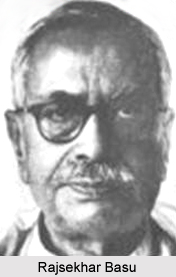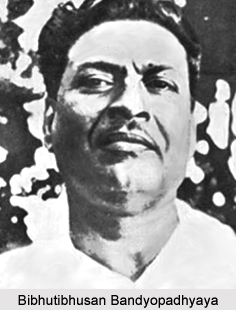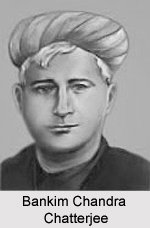 Development of Bengali prose in Twentieth century needs to be traced to an earlier period in order to be understood properly. The Bengali prose of the twentieth century can be best understood by taking a look at the individual writers and their works. The most important fiction writer in Bengali literature after Sarat Chandra Chatterjee was Bibhutibhusan Bandyopadhyaya (1899- 1950), who, in a short life span, produced some of the most remarkable Bengali novels. His works exhibit a rather distinct psychological depth. Bibhutibhusan will be best remembered for his Apu novels, Pather Panchali (Song of the Road, 1929) and its sequel, Aparajito (Undefeated, 1932), a fictionalized version of the author`s own life. Pather Panchali, especially, paints a poignant picture of rural life and the journey of a poor Brahmin family through the eyes of a child protagonist. The two novels were turned into the famous Apu trilogy films by Satyajit Ray in the 1960s. Among his other works are Aranyak (The Wild, 1938), Adarsa Hindu Hotel (The Ideal Hindu Hotel, 1940), and Anubartan (Recycle, 1942). He also wrote books for children and numerous short stories.
Development of Bengali prose in Twentieth century needs to be traced to an earlier period in order to be understood properly. The Bengali prose of the twentieth century can be best understood by taking a look at the individual writers and their works. The most important fiction writer in Bengali literature after Sarat Chandra Chatterjee was Bibhutibhusan Bandyopadhyaya (1899- 1950), who, in a short life span, produced some of the most remarkable Bengali novels. His works exhibit a rather distinct psychological depth. Bibhutibhusan will be best remembered for his Apu novels, Pather Panchali (Song of the Road, 1929) and its sequel, Aparajito (Undefeated, 1932), a fictionalized version of the author`s own life. Pather Panchali, especially, paints a poignant picture of rural life and the journey of a poor Brahmin family through the eyes of a child protagonist. The two novels were turned into the famous Apu trilogy films by Satyajit Ray in the 1960s. Among his other works are Aranyak (The Wild, 1938), Adarsa Hindu Hotel (The Ideal Hindu Hotel, 1940), and Anubartan (Recycle, 1942). He also wrote books for children and numerous short stories.
Two of Bibhutibhusan`s lesser contemporaries were Achintyakumar Sengupta (1903-76) and Sailajananda Mukhopadhyaya (1900-1976). Although Sengupta was very prolific and popular, he did not always succeed artistically. His best works include Bede (The Gypsy, 1928) and Prachir O Prantar (The Wall and the Distance, 1932). He is well known for a host of short stories that he wrote over an extended writing career. Mukhopadhyaya`s fame rests mainly on his sympathetic depiction of the life of the coal miners in the place he came from, Bardhaman District. His treatment is often realistic, and the stories tragic. His best-remembered works include two short story collections, Kaylakuthi (The Coal Miner`s Office, 1930) and Din Majur (Day Laborer, 1932), and the novels Jhoro Haoa (Stormy Wind, 1923) and Solo Ana (Sixteen Annas, 1925).
 Among the fiction writers who wrote their best works during the political transition period of India from British rule to independence (1947) are Sanjay Bhattacharya (1909-69), who wrote in the style of the "novel of ideas," and Jagadis Gupta (1886-1957). Gupta is also regarded by some historians as a member of the Kallol group. He is also the precursor of one of the most prominent novelists of this period, Manik Bandyopadhyaya (1910-56). Bandyopadhyaya was an active political worker from East Bengal, and his work is filled with impressions of the natural surroundings and the people of that region. Nature and human beings are shown to face each other as both adversaries and allies in his famous and mystery novel Padma Nadir Majhi (The Boatman of the River Padma, 1936, English in 1948). Manik will also be remembered for his Putul Nacher Itikatha (The Story of the Puppet Dance, 1936), also on the subject of nature`s unfair clashes with human beings, who are themselves deeply rooted in the unpreventable complexities of their own psychophysical desires. Manik Bandyopadhyaya also wrote several short stories, among which are Pragaitihasik (Prehistoric, 1937) and Aj-Kal-Parsur Galpa (Stories of Today, Tomorrow and the Day After, 1946). A brilliant film version of Padma Nadir Majhi was made by Gautam Ghosh in 1992.
Among the fiction writers who wrote their best works during the political transition period of India from British rule to independence (1947) are Sanjay Bhattacharya (1909-69), who wrote in the style of the "novel of ideas," and Jagadis Gupta (1886-1957). Gupta is also regarded by some historians as a member of the Kallol group. He is also the precursor of one of the most prominent novelists of this period, Manik Bandyopadhyaya (1910-56). Bandyopadhyaya was an active political worker from East Bengal, and his work is filled with impressions of the natural surroundings and the people of that region. Nature and human beings are shown to face each other as both adversaries and allies in his famous and mystery novel Padma Nadir Majhi (The Boatman of the River Padma, 1936, English in 1948). Manik will also be remembered for his Putul Nacher Itikatha (The Story of the Puppet Dance, 1936), also on the subject of nature`s unfair clashes with human beings, who are themselves deeply rooted in the unpreventable complexities of their own psychophysical desires. Manik Bandyopadhyaya also wrote several short stories, among which are Pragaitihasik (Prehistoric, 1937) and Aj-Kal-Parsur Galpa (Stories of Today, Tomorrow and the Day After, 1946). A brilliant film version of Padma Nadir Majhi was made by Gautam Ghosh in 1992.
A contemporary of Manik Bandyopadhyaya was Tarashankar Bandyopadhyay, who hailed from Birbhum district in West Bengal, and also used the familiar locale of his home as a setting for his stories. Like most Bengali fiction writers, Tarasankar wrote short stories as well as novels. His novels are marked with a remarkable clarity of expression, a keen sense of drama, and a heartfelt sympathy for rural folk. The last explains why the best of his stories and novels are set in village surroundings. His noted novels are Dhatri Debata (The Nursing Deity, 1939), Kalindi (1940), Ganadebata (Dieux Populi, 1942), and Hasuli Baker Upakatha (The Legend of the Hasuli Bend, 1947). Almost all of his novels have been turned into commercially successful films. His short story "Jalsaghar" (The Music Room, 1937), a touching tale of the last days of an impoverished aristocrat, was turned into an acclaimed film by Satyajit Ray.
Narayan Gangopadhyaya (1918-70) was another noted fiction writer who emerged at around the same time as Tarasankar and Manik Bandyopadhyaya. Although he, too, started with rural life as his primary material, very soon he was dealing with life in metropolitan Kolkata. Two of his important novels, out of dozens, are Upanibes (The Colony, 1943) and Megher Upar Prasad (Castles upon Clouds, 1963). He also wrote several short stories and one-act plays for adults and children. Another major writer from this period is Narendranath Mitra (1916-75), whose works include Bini Sutor Mala (1962) and Andgata (1972), a collection of short stories.
 Samares Basu (1923-89), generally referred to as the successor of Manik Bandyopadhyaya. Basu comes from the Leftist bloc of Bengali prose writers. He has written extensively on subjects dealing with the oppressed lower and middle classes. He is one of the foremost literary writers in Bengali literature due to the sharpness of his prose, its realism and dramatic plots. His major works include Ganga (1957), Bihar (1966), Bi ti Roder Dhare (1953), Joarbhana (Ebb and Tide, 1960), Prajapati (1967), Par (The Crossing, 1978), and Dekhi Nai Phire (Haven`t Turned to Look Back, 1988). Basu also wrote under the pen name of Kalkut, producing semi-mythological novels like Amrita Kumbher Sandhane and Samba. He was also a prolific master of the short story genre. A number of his short stories and novels have been turned into films and plays.
Samares Basu (1923-89), generally referred to as the successor of Manik Bandyopadhyaya. Basu comes from the Leftist bloc of Bengali prose writers. He has written extensively on subjects dealing with the oppressed lower and middle classes. He is one of the foremost literary writers in Bengali literature due to the sharpness of his prose, its realism and dramatic plots. His major works include Ganga (1957), Bihar (1966), Bi ti Roder Dhare (1953), Joarbhana (Ebb and Tide, 1960), Prajapati (1967), Par (The Crossing, 1978), and Dekhi Nai Phire (Haven`t Turned to Look Back, 1988). Basu also wrote under the pen name of Kalkut, producing semi-mythological novels like Amrita Kumbher Sandhane and Samba. He was also a prolific master of the short story genre. A number of his short stories and novels have been turned into films and plays.
Rajsekhar Basu (1880-1960), mainly a philologist and a major translator of ancient literary masterpieces of India, is better known among Bengali readers as Parashuram, a pseudonym he used for his creative writing that was predominantly satirical. One of his well-known stories, Mahapurush, about an amateur sleuth who uncovers a holy man`s fraud, was made into a short film by Satyajit Ray. Among his major translation works are the Ramayana and the Mahabharata, along with Kalidasa`s famous Sanskrit poem Meghaduta into Bengali prose.
Sibram Chakrabarti (1909-80) was one of the most popular humorists Bengali literature has known, along with Syed Mujtaba Ali (1904-74). The most dearly remembered humorist in Bengali literature, however, is Sukumar Ray (1887-1923), who is the progenitor of the nonsense-rhyme genre in Bengali. His famous book of nonsense poems, Abol-Tabol (Gibber-Gabber, 1923), continues to be one of the first books read to a Bengali child. Sukumar Ray also wrote several other humorous tales and plays and was the editor of Sandesh, a magazine for children founded by his father, Upendra Kishor Raychaudhuri (1863-1915). Sukumar Ray was the father of Satyajit Ray.
Among the older writers, predominantly novelists and short story writers, who continue to write or have passed away only recently are Annadasakar Ray (1904), Jarasandha (1904), Jajabar (1909), Satinath Bhaduri (1906-65), Kamal Kumar Majumdar (1915-79), Bibhutibhusan Mukhopadhyaya (1896-1987), Prabodhkumar Sanyal (1907-83), Subodh Ghos (1909-80), Manoj Basu (1901-79), Gopal Haldar (1902-93), Saradindu Bandyopadhyaya (1899-1970), who is best known for his detective and semi-historical novels, Bimal Mitra (1912) Saktipada Rajguru, and Asutos Mukhopadhyaya (1920). Two other major novelists from this period are Dhurjatiprasad Mukhopadhyay (1894-1961) and Adwaita Mallabarman. Of the two, Mallabarman died prematurely but will be remembered for his singular work Titas Ekti Nadir Naam (Titas Is the Name of a River, 1962), brilliantly filmed in the early 1970s by Ritwik Ghatak.
 Among the older contemporary prose writers who started in the 1960s and are still writing, the most noteworthy figures are Sunil Gangopadhyay (1934) and Sarikar (Manisarikar Bandyopadhyaya (1933). Gangopadhyaya, who also doubles as a poet, continues to write prolifically and is one of the most popular writers of today. His novels are set predominantly in urban, middle-class environs. He also writes under the pseudonym of Nilalohit (Blue-Blooded). His major works include Aranyer Dinratri, Pratidwandi, Arjun and Sei Samay. Of these four, the first two were made into films by Satyajit Ray. Sarikar commands the same popularity that Gangopadhyaya does, if not more, and has also written novels that continue to be best-sellers. His best-known works are Chowringhee, Nibedita Risarch Lyaboratari, Simabaddha, Jana Aranya and Marubhumi. Simabaddha, Chowringhee and Jana Aranya were made into feature films by Satyajit Ray.
Among the older contemporary prose writers who started in the 1960s and are still writing, the most noteworthy figures are Sunil Gangopadhyay (1934) and Sarikar (Manisarikar Bandyopadhyaya (1933). Gangopadhyaya, who also doubles as a poet, continues to write prolifically and is one of the most popular writers of today. His novels are set predominantly in urban, middle-class environs. He also writes under the pseudonym of Nilalohit (Blue-Blooded). His major works include Aranyer Dinratri, Pratidwandi, Arjun and Sei Samay. Of these four, the first two were made into films by Satyajit Ray. Sarikar commands the same popularity that Gangopadhyaya does, if not more, and has also written novels that continue to be best-sellers. His best-known works are Chowringhee, Nibedita Risarch Lyaboratari, Simabaddha, Jana Aranya and Marubhumi. Simabaddha, Chowringhee and Jana Aranya were made into feature films by Satyajit Ray.
Among the women prose writers who have made a major contribution to the genre are Asapurna Debi (1909), Mahasweta Devi (1926), Maitreyi Debi (1914-88), and Lila Majumdar (1908). Ashapurna Devi is known for her remarkably perceptive and intimate study of the role of the woman in a patriarchal, middle-class milieu, best represented in her semiautobiographical trilogy, Pratham Pratisruti (The First Promise), Subarnalata, and Bakul Katha (Bakul`s Story). Daughter of the Kallol generation writer Manis Ghatak Mahasweta Devi has contributed to Bengali prose writing with her extensive work on the sub-altern aboriginal peoples of Bengal and adjacent Bihar. Her noteworthy works in this area are Aranyer Adhikar (The Rights of the Forest, 1978) and Cotti Munda Ebang Tar Tir (Cotti Munda and His Arrows, 1981). She has also written extensively on the urban situation, best represented by Hajar Churasir Ma (Mother of 1084, 1986), which was also made into a play, and short stories like "Stanyaayini" (Breast-Giver, 1977) and "Rudali" (Weepers, 1980). Maitreyi Debi is best known for her semiautobiographical novel Na Hanyate (It Does Not Die, 1975) and her informative recollections on Tagore. Lila Majumdar has written extensively for children. Among other major women prose writers are Pratibha Basu, from the older generation, and Nabanita Deb-Sen, who is also a poet from the younger.
Bengali prose literature has always boasted a high output in prose productions of all standards throughout the twentieth century. The legacy of Rabindranath Tagore, Sarat Chandra, Bibhutibhusan, and Manik Bandyopadhyaya has been carried forward bravely by forthcoming generations.



















